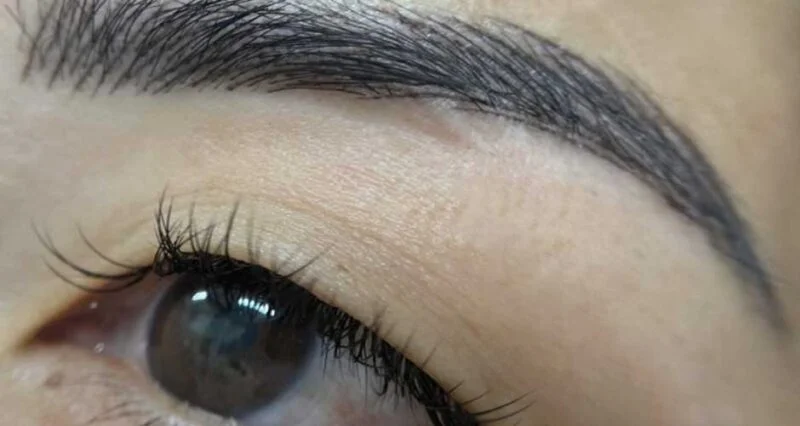
Permanent makeup has become a popular beauty trend for those seeking a low-maintenance, flawless look. Whether you’re considering enhancing your eyebrows, defining your lips, or adding a permanent eyeliner, this guide will provide you with all the information you need to make an informed decision. From understanding what permanent makeup is to knowing what to expect during and after the procedure, here’s everything you need to know.
What Is Permanent Makeup?
Permanent makeup, also known as cosmetic tattooing or micropigmentation, is a technique that involves the application of pigments into the upper layers of the skin to replicate the look of makeup. The permanent makeup process involves depositing pigments into the dermal layer of the skin using specialized tools. This process can be used to enhance features such as eyebrows, lips, and eyes, providing a long-lasting solution that can save time and effort in your daily beauty routine.
Unlike traditional tattoos, the pigments used in permanent makeup are designed to fade gradually over time, typically lasting between 1 to 3 years, depending on factors like skin type, lifestyle, and the area treated.
How Does Permanent Makeup Work?
Permanent makeup, also known as cosmetic tattooing, involves depositing pigments into the dermal layer of the skin using specialized tools. This process can be performed with a machine or a manual tool, depending on the technique and area being treated. The initial session typically lays the foundation, while multiple touch-up sessions help achieve the desired look.
A skilled permanent makeup artist uses a fine needle to create natural-looking hair strokes for eyebrows, define the lash line with precision, or add a beautiful tint to the lips. The pigments used are designed to be long-lasting, but factors such as skin type, sun exposure, and lifestyle can influence how quickly they fade. By understanding the intricacies of your skin type and following the artist’s aftercare instructions, you can enjoy the benefits of permanent makeup for years to come.
Types of Permanent Makeup
Permanent makeup can be applied to various areas of the face, each with its own specific techniques and benefits. These procedures are often referred to as cosmetic tattoos, offering long-lasting results and various aesthetic enhancements:
- Microblading (Eyebrows)
- Microblading is a popular method for enhancing the eyebrows, providing natural looking brows by using a fine blade to create hair-like strokes that mimic the appearance of natural eyebrow hairs. This technique is ideal for those with sparse or thinning brows, offering a natural-looking solution that can last up to 18 months.
- Lip Blushing (Lips)
- Lip blushing is a technique used to enhance the natural color and shape of the lips. It involves the application of pigment to create a fuller, more defined look. Permanent lip liner is another option that defines the lip shape and can be combined with lip blushing for a more comprehensive enhancement. Lip blushing can also help correct asymmetry and add a subtle tint to the lips, eliminating the need for daily lipstick application.
- Permanent Eyeliner
- Permanent eyeliner is designed to define and accentuate the eyes. This technique involves the precise application of pigment along the lash line, creating a look that can range from subtle enhancement to a more dramatic effect. Lash line enhancement is a popular option that involves tattooing a dark line within the lash line to provide extra definition and the appearance of fuller lashes. Permanent eyeliner is perfect for those who want to save time on their daily makeup routine or who have difficulty applying eyeliner.
- Scalp Micropigmentation
- Scalp micropigmentation is a technique used to create the appearance of fuller hair. It involves the application of tiny dots of pigment on the scalp to replicate the look of natural hair follicles. This treatment is commonly used to address thinning hair or bald spots.
- Areola Restoration
- Areola restoration is a specialized form of permanent makeup used to recreate or enhance the appearance of the areola, often following breast surgery. This technique can help restore a natural look and boost confidence.
Benefits of Permanent Makeup
Permanent makeup offers a myriad of benefits that go beyond just saving time in your daily routine. Imagine waking up with perfectly shaped eyebrows, defined eyes, and beautifully tinted lips without the need for daily makeup application. This convenience is a significant time-saver, especially for busy professionals and those with active lifestyles.
Beyond practicality, permanent makeup can boost your confidence by enhancing your natural features and addressing aesthetic concerns such as uneven skin tone, sparse hairlines, and scars. Whether you want to mimic your favorite makeup look or achieve a more polished appearance, permanent makeup provides a long-lasting solution. With proper maintenance, the results can last for several years, making it a worthwhile investment for beauty enthusiasts and minimalists alike.
Risks and Complications of Permanent Makeup
While permanent makeup is generally safe, it’s essential to be aware of potential risks and complications. These can include infection, allergic reactions, and scarring. To minimize these risks, it’s crucial to choose a qualified and experienced permanent makeup artist who follows strict hygiene practices.
Proper aftercare is also vital to ensure a smooth healing process and long-lasting results. This includes following the artist’s instructions, avoiding certain activities, and protecting the treated area from sun exposure. It’s important to note that permanent makeup may not be suitable for everyone, particularly those with certain medical conditions. Always consult with a professional to determine if this beauty treatment is right for you.
The Permanent Makeup Procedure: What to Expect
The process of getting permanent makeup typically involves several steps, each designed to ensure that you achieve the desired results with minimal discomfort:
- Consultation
- Your journey begins with a consultation with a trained and licensed permanent makeup artist. During this session, you’ll discuss your goals, preferences, and any concerns you might have. The artist will evaluate your skin type and facial structure to recommend the best approach for your needs.
- Design and Color Selection
- Before the procedure begins, your artist will work with you to design the shape and select the pigment color that best complements your natural features. This step is crucial for achieving a look that is both flattering and harmonious with your overall appearance.
- Numbing
- To ensure your comfort, a topical numbing cream is applied to the treatment area before the procedure begins. This helps minimize any discomfort you might feel during the process.
- Application
- The artist will use a specialized tool, such as a microblade or tattoo machine, to carefully apply the pigment to your skin. The procedure can take anywhere from 1 to 3 hours, depending on the area being treated and the complexity of the design.
- Aftercare Instructions
- After the procedure, your artist will provide you with detailed aftercare instructions to help ensure proper healing and long-lasting results. This may include avoiding certain activities, applying healing ointments, and protecting the treated area from sun exposure.
Aftercare and Healing Process
The aftercare process is essential for achieving the best results from your permanent makeup. Immediately following the procedure, the treated area may appear darker and more intense than expected, but this will gradually soften as the skin heals.
Here are some general aftercare tips:
- Avoid Water Exposure:Keep the treated area dry for the first few days. Avoid swimming, saunas, and heavy sweating to prevent infection and pigment loss.
- Use Healing Ointments:Apply any recommended ointments as directed by your artist to promote healing and protect the pigment.
- Protect from Sun Exposure:Sun exposure can cause the pigment to fade prematurely. Use a hat or apply a high SPF sunscreen once the area has fully healed.
- Avoid Picking or Scratching:It’s normal for the treated area to scab or peel slightly as it heals. Avoid picking at the skin to prevent scarring or uneven pigment retention.
- Follow-Up Appointment:A follow-up appointment is usually scheduled 4 to 6 weeks after the initial procedure to touch up any areas where the pigment may have faded.
Longevity and Maintenance
Permanent makeup services offer long-lasting results, but periodic touch-ups are necessary to maintain the desired look. Permanent makeup is designed to fade gradually over time, requiring periodic touch-ups to maintain the desired look. The longevity of your results depends on several factors, including:
- Skin Type:Oily skin tends to break down pigment faster than dry or normal skin.
- Sun Exposure:UV rays can cause the pigment to fade more quickly.
- Lifestyle:Activities like swimming, frequent exfoliation, and the use of certain skincare products can affect the longevity of your permanent makeup.
- Color Selection:Lighter pigments tend to fade faster than darker ones.
On average, you can expect to need a touch-up every 12 to 18 months to keep your permanent makeup looking fresh and vibrant.
Removing Permanent Makeup
Removing permanent makeup can be a challenging process, and the options available depend on how long you’ve had the makeup. Traditional laser removal methods are not always suitable for micropigmentation and may cause further damage. However, other options such as laser and bleaching treatments can help accelerate the fading process or remove the pigment altogether.
It’s essential to consult with a qualified professional to determine the best course of action for removing permanent makeup. They can assess your specific situation and recommend the most effective and safe method. Remember, the removal process can be complex, so it’s crucial to seek expert advice to achieve the best possible outcome.
Is Permanent Makeup Right for You?
Permanent makeup is an excellent option for those looking to simplify their beauty routine, enhance their natural features, or address specific cosmetic concerns. The permanent makeup industry offers a range of services that can enhance your natural features and simplify your beauty routine. It’s especially beneficial for:
- Busy Professionals:Save time in your daily routine with brows, lips, and eyeliner that are always ready to go.
- Active Lifestyles:Enjoy a polished look even during workouts or outdoor activities without worrying about makeup smudging or wearing off.
- Those with Allergies or Sensitivities:Permanent makeup is a great alternative for those who are allergic or sensitive to traditional makeup products.
- Individuals with Hair Loss:Whether due to medical conditions, aging, or other factors, permanent makeup can help restore the appearance of eyebrows, eyelashes, or scalp hair.
Choosing a Permanent Makeup Artist
Selecting a qualified and experienced permanent makeup artist is crucial for achieving safe and satisfying results. Here are some tips for choosing the right artist:
- Check Credentials:Ensure the artist is licensed and certified in permanent makeup.
- Review Their Portfolio:Look at before-and-after photos of previous clients to assess the artist’s skill and style.
- Read Reviews:Check online reviews and testimonials to gauge the experiences of other clients.
- Ask Questions:Don’t hesitate to ask questions about the artist’s experience, the procedure, and the products used.
In conclusion, permanent makeup offers a convenient and long-lasting solution for those looking to enhance their natural beauty. By understanding the different types of permanent makeup, what to expect during the procedure, and how to care for your results, you can make an informed decision about whether this beauty treatment is right for you. With the right artist and proper aftercare, permanent makeup can help you achieve a flawless look that lasts for years, giving you more time to focus on what truly matters in your life.
This article was written by HL Studio + Ink. Find them here:

